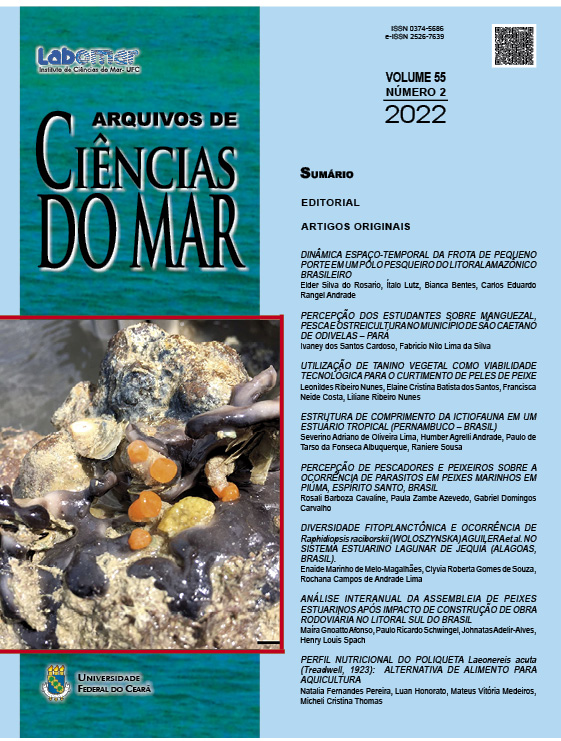Nutritional profile of the polychaete Laeonereis acuta (Treadwell, 1923): a food alternative for aquaculture
DOI:
https://doi.org/10.32360/acmar.v55i2.70819Abstract
The species Laeonereis acuta, is a detritivore nereidid found in estuarine regions with sandy and silty sediments. The distribution occurs on the Atlantic coast of American continent, from Recife (Brazil) to the Valdez Peninsula (Argentina). In addition to the ecological role, polychaetes are used in ecotoxicological studies, as fishing baits and as feed for aquatic organisms. Therefore, the aim was to analyze the nutritional profile of the wild L. acuta and to evaluate its potential as feed in aquaculture. Samples of polychaetes (200 g) were carried out in the intertidal regions of Santo Antônio dos Anjos Lagoon, in Laguna (Santa Catarina, Brazil), between the months of February and June 2018. The centesimal composition of L. acuta showed a percentage of protein (67.5%) superior to that found in several species of polychaetes. Regarding total lipids, the percentage of 6.6% of the present study was similar to the minimum values (6.6%) found in studies with wild polychaetes. However, further studies are needed regarding the nutritional profile of different populations of this species and in other environmental conditions. The use of L. acuta is recommended
as a complementary source to a balanced diet to meet the nutritional needs of aquaculture species.
Keywords: proteins, fatty acids, carbohydrates, animal nutrition, aquaculture.
Downloads
Published
Issue
Section
License
1. Proposta de Política para Periódicos de Acesso Livre
Autores que publicam nesta revista concordam com os seguintes termos:
- Autores mantém os direitos autorais e concedem à revista o direito de primeira publicação, com o trabalho simultaneamente licenciado sob a Licença Creative Commons Attribution que permite o compartilhamento do trabalho com reconhecimento da autoria e publicação inicial nesta revista.
- Autores têm autorização para assumir contratos adicionais separadamente, para distribuição não-exclusiva da versão do trabalho publicada nesta revista (ex.: publicar em repositório institucional ou como capítulo de livro), com reconhecimento de autoria e publicação inicial nesta revista.
- Autores têm permissão e são estimulados a publicar e distribuir seu trabalho online (ex.: em repositórios institucionais ou na sua página pessoal) a qualquer ponto antes ou durante o processo editorial, já que isso pode gerar alterações produtivas, bem como aumentar o impacto e a citação do trabalho publicado (Veja O Efeito do Acesso Livre).

